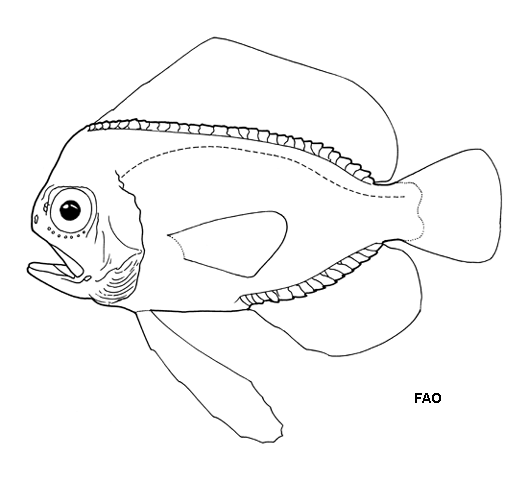| Caristiidae (Manefishes) |
| 13.9 cm SL (male/unsexed); max.weight: 123.0 g |
|
bathypelagic; marine; depth range 1 - 2000 m |
| Eastern Atlantic. |
|
Dorsal soft rays (total): 27-29; Anal soft rays: 17-19; Vertebrae: 32-34. This species is distinguished by the following characters: differs from P. paucus by having greater number of dorsal-fin rays (27-29 vs. 24-25), anal-fin rays (17-19 vs. 15-16), pectoral-fin rays (17-20 vs. 16-17), and vertebrae (32-34 vs. 31); from P. andriashevi by having fewer dorsal-fin rays (27-29 vs. 31-37), anal-fin rays (17-19 vs. 19-22), and vertebrae (32-34 vs. 36-39); and from both species by caudal-fin morphology (ventral caudal spur absent, procurrent rays cylindrical vs. ventral caudal spur present, procurrent rays flattened, bladelike); differs from P. rhyton and P. mauli by morphometrics, including a deeper body (52-64% vs. 45-52% SL), longer head length (>38% vs. <34% SL), longer prepectoral length (>39% vs. <36% SL), and smaller mouth (upper jaw extending approximately to mid-orbit vs. posterior margin of orbit); differs from P. pietschi by caudal-fin morphology (ventral caudal spur absent, procurrent rays cylindrical vs. ventral caudal spur present, procurrent rays flattened, bladelike) and gill-raker morphology (bristles on gill rakers small and uniform vs. small bristles and large spikes on rakers) (Ref. 94277). |
| Max. length of a photo (Rógvi Mouritsen, pers. comm., 2003). |
|
Least Concern (LC); Date assessed: 07 May 2013 Ref. (130435)
|
| harmless |
|
Source and more info: www.fishbase.org. For personal, classroom, and other internal use only. Not for publication.

